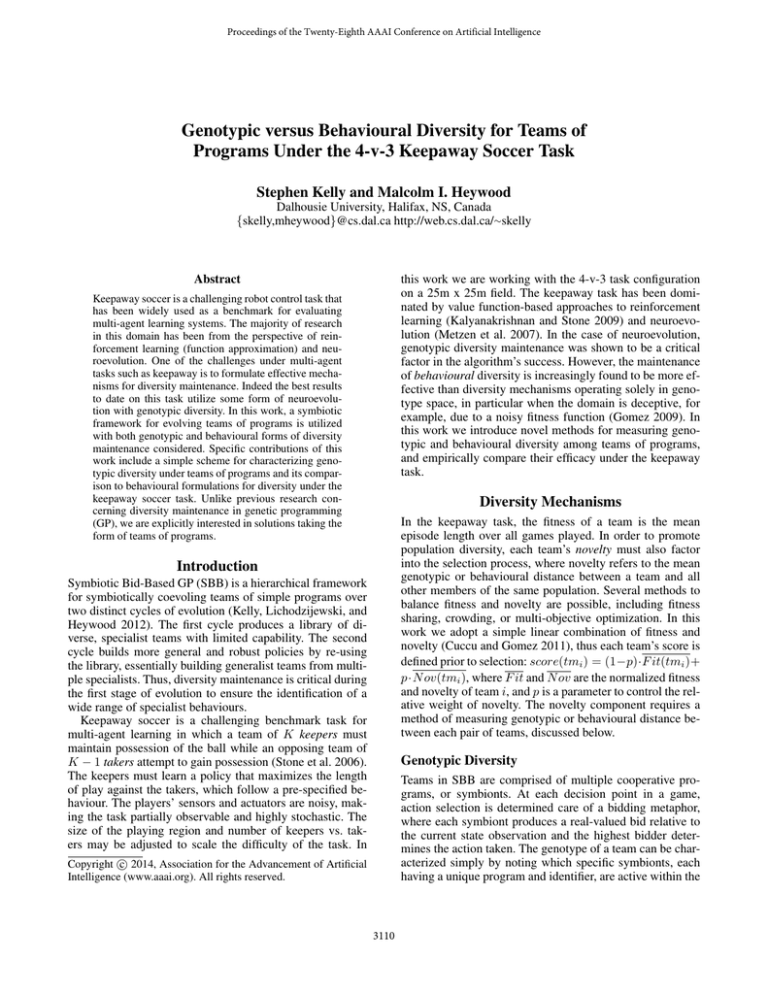
Proceedings of the Twenty-Eighth AAAI Conference on Artificial Intelligence
Genotypic versus Behavioural Diversity for Teams of
Programs Under the 4-v-3 Keepaway Soccer Task
Stephen Kelly and Malcolm I. Heywood
Dalhousie University, Halifax, NS, Canada
{skelly,mheywood}@cs.dal.ca http://web.cs.dal.ca/⇠skelly
Abstract
this work we are working with the 4-v-3 task configuration
on a 25m x 25m field. The keepaway task has been dominated by value function-based approaches to reinforcement
learning (Kalyanakrishnan and Stone 2009) and neuroevolution (Metzen et al. 2007). In the case of neuroevolution,
genotypic diversity maintenance was shown to be a critical
factor in the algorithm’s success. However, the maintenance
of behavioural diversity is increasingly found to be more effective than diversity mechanisms operating solely in genotype space, in particular when the domain is deceptive, for
example, due to a noisy fitness function (Gomez 2009). In
this work we introduce novel methods for measuring genotypic and behavioural diversity among teams of programs,
and empirically compare their efficacy under the keepaway
task.
Keepaway soccer is a challenging robot control task that
has been widely used as a benchmark for evaluating
multi-agent learning systems. The majority of research
in this domain has been from the perspective of reinforcement learning (function approximation) and neuroevolution. One of the challenges under multi-agent
tasks such as keepaway is to formulate effective mechanisms for diversity maintenance. Indeed the best results
to date on this task utilize some form of neuroevolution with genotypic diversity. In this work, a symbiotic
framework for evolving teams of programs is utilized
with both genotypic and behavioural forms of diversity
maintenance considered. Specific contributions of this
work include a simple scheme for characterizing genotypic diversity under teams of programs and its comparison to behavioural formulations for diversity under the
keepaway soccer task. Unlike previous research concerning diversity maintenance in genetic programming
(GP), we are explicitly interested in solutions taking the
form of teams of programs.
Diversity Mechanisms
In the keepaway task, the fitness of a team is the mean
episode length over all games played. In order to promote
population diversity, each team’s novelty must also factor
into the selection process, where novelty refers to the mean
genotypic or behavioural distance between a team and all
other members of the same population. Several methods to
balance fitness and novelty are possible, including fitness
sharing, crowding, or multi-objective optimization. In this
work we adopt a simple linear combination of fitness and
novelty (Cuccu and Gomez 2011), thus each team’s score is
defined prior to selection: score(tmi ) = (1 p)·F it(tmi )+
p·N ov(tmi ), where F it and N ov are the normalized fitness
and novelty of team i, and p is a parameter to control the relative weight of novelty. The novelty component requires a
method of measuring genotypic or behavioural distance between each pair of teams, discussed below.
Introduction
Symbiotic Bid-Based GP (SBB) is a hierarchical framework
for symbiotically coevoling teams of simple programs over
two distinct cycles of evolution (Kelly, Lichodzijewski, and
Heywood 2012). The first cycle produces a library of diverse, specialist teams with limited capability. The second
cycle builds more general and robust policies by re-using
the library, essentially building generalist teams from multiple specialists. Thus, diversity maintenance is critical during
the first stage of evolution to ensure the identification of a
wide range of specialist behaviours.
Keepaway soccer is a challenging benchmark task for
multi-agent learning in which a team of K keepers must
maintain possession of the ball while an opposing team of
K 1 takers attempt to gain possession (Stone et al. 2006).
The keepers must learn a policy that maximizes the length
of play against the takers, which follow a pre-specified behaviour. The players’ sensors and actuators are noisy, making the task partially observable and highly stochastic. The
size of the playing region and number of keepers vs. takers may be adjusted to scale the difficulty of the task. In
Genotypic Diversity
Teams in SBB are comprised of multiple cooperative programs, or symbionts. At each decision point in a game,
action selection is determined care of a bidding metaphor,
where each symbiont produces a real-valued bid relative to
the current state observation and the highest bidder determines the action taken. The genotype of a team can be characterized simply by noting which specific symbionts, each
having a unique program and identifier, are active within the
Copyright c 2014, Association for the Advancement of Artificial
Intelligence (www.aaai.org). All rights reserved.
3110
team. A symbiont is considered active if it has scored a winning bid, and thus suggested an action for the task domain, at
least once during the life of the team. Genotypic distance between teams is summarized as the ratio of active symbionts
common to both teams. Formally, the genotypic distance between teams i and k is
Symactive (tmi ) \ Symactive (tmk )
dist(tmi , tmk ) = 1
Symactive (tmi ) [ Symactive (tmk )
(1)
where Symactive (tmx ) represents the set of active symbionts in team x.
●
●
●
●
●
●
●
●
●
●
●
●
●
●
●
●
●
●
●
●
●
●
●
●
●
●
●
●
Behavioural Diversity
The behaviour of a host is summarized with respect to behavioural attributes recorded over the course of each game.
At each timestep, the observation, 19 real-valued state variables in the case of 4-v-3 keepaway, and subsequent action taken by the keeper are recorded. Each state variable
is discretized to [0, 1, 2], or low, medium, high. Thus, for
each training episode a profile vector is recorded, p~ =
[{a(t), s(t)}, t 2 T ], where a(t) is the discrete, domainspecific action taken at each timestep, s(t) is the discretized
state observation, and T represents every timestep in the associated episode. Note that this method of characterizing behaviour is task-independent. In every generation, each team
is evaluated in 10 new games. Teams maintain a historical
record of the profile p~ for 100 games. Once the team’s historical record is full, it is no longer evaluated. However, it
stays in the population as long as it is not marked for deletion
by the selection process. We define P~ to be the concatenation of all profile vectors p~ in a team’s historical record. Behavioural distance between a pair of teams can now be summarized as the Normalized Compression Distance (Gomez
2009) between their corresponding concatenated profile vectors: dist(tmi , tmk ) = ncd(P~i , P~k )
●
●
Figure 1: Average performance of champion policy against
1,000 test games. Box plot reflects the quartile distribution
and scatter plot the actual performance points from 10 runs.
Numerical value reports the median of the 10 runs.
Conclusion
We have introduced a simple genotypic diversity measure
applicable to teams of programs and compared this with
a behavioural, task-independent diversity characterization.
While both diversity mechanisms are beneficial relative to
the case of no diversity, the development of hierarchical polices has been shown to benefit more from behavioural diversity maintenance than from the genotypic formulation.
References
Results
Cuccu, G., and Gomez, F. 2011. When novelty is not
enough. In EvoApplications – Part I, volume 6624 of LNCS.
Gomez, F. 2009. Sustaining diversity using behavioral information distance. In ACM Conference on Genetic and Evolutionary Computation.
Kalyanakrishnan, S., and Stone, P. 2009. An empirical analysis of value function-based and policy search reinforcement
learning. In Proceedings of the International Conference on
Autonomous Agents and Multiagent Systems.
Kelly, S.; Lichodzijewski, P.; and Heywood, M. I. 2012.
On run time libraries and hierarchical symbiosis. In IEEE
Congress on Evolutionary Computation.
Metzen, J. H.; Edgington, M.; Kassahun, Y.; and Kirchner,
F. 2007. Performance evaluation of EANT in the robocup
keepaway benchmark. In IEEE International Conference on
Machine Learning and Applications.
Stone, P.; Kuhlmann, G.; Taylor, M.; and Liu, Y. 2006.
Keepaway soccer: From machine learning testbed to benchmark. In RoboCup 2005: Robot Soccer World Cup IX.
Three experimental cases are considered. In each case, hierarchical policies are developed over two cycles of evolution
with 250 generations in the first cycle and 125 generations in
the second. During the first cycle, case 1 employs no diversity maintenance, case 2 employs genotypic diversity, and
case 3 employs behavioural diversity. No diversity maintenance is used during the second cycle of evolution, where the
goal is strictly exploitative. The parameter p was fixed at 0.1
and 0.4 for genotypic and behavioural diversity respectively.
These values were determined experimentally and are not
necessarily optimal. Figure 1 reports the test performance
of the champion team from each experimental case at the
end of the second evolutionary cycle. It is apparent that policies with behavioural diversity in the first cycle are able to
achieve significantly better performance in the second cycle,
or exploitation phase. This suggests that behavioural diversity is most effective when constructing a library of reusable
specialist policies. Wilcoxon rank-sum test confirms statistical significance between groups of all 10, 000 test outcomes
from behavioural vs. no diversity and behavioural vs. genotypic (p < 0.05).
3111




